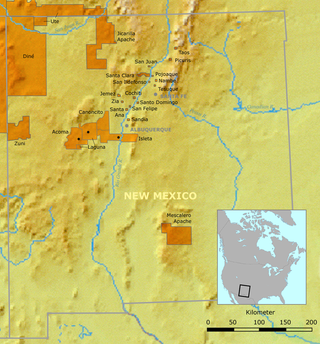
The Puebloans, or Pueblo peoples, are Native Americans in the Southwestern United States who share common agricultural, material, and religious practices. Among the currently inhabited Pueblos, Taos, San Ildefonso, Acoma, Zuni, and Hopi are some of the most commonly known. Pueblo people speak languages from four different language families, and each Pueblo is further divided culturally by kinship systems and agricultural practices, although all cultivate varieties of maize.

The Hopi are Native Americans who primarily live in northeastern Arizona. The majority are enrolled in the Hopi Tribe of Arizona and live on the Hopi Reservation in northeastern Arizona; however, some Hopi people are enrolled in the Colorado River Indian Tribes of the Colorado River Indian Reservation at the border of Arizona and California.
Hopi is a Uto-Aztecan language spoken by the Hopi people of northeastern Arizona, United States.

Nampeyo was a Hopi-Tewa potter who lived on the Hopi Reservation in Arizona. Her Tewa name was also spelled Num-pa-yu, meaning "snake that does not bite". Her name is also cited as "Nung-beh-yong," Tewa for Sand Snake.
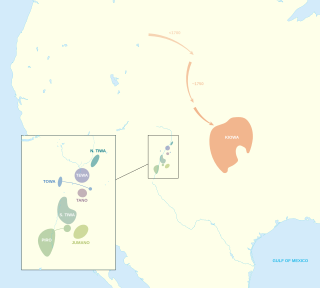
Tanoan, also Kiowa–Tanoan or Tanoan–Kiowa, is a family of languages spoken by indigenous peoples in present-day New Mexico, Kansas, Oklahoma, and Texas.
Tewa is a Tanoan language spoken by some Pueblo people, mostly in the Rio Grande valley in New Mexico north of Santa Fe, and in Arizona. It is also known as Tano, or Tée-wah (archaic). There is some disagreement among the Tewa people about whether or not Tewa should have a written form, as some Pueblo elders believe that their language should be preserved by oral tradition alone. Because of this, it was not until the 1960s that the language was written down for the first time. However, many Tewa speakers have decided that Tewa literacy is an important aspect in passing down the language and so orthographies have been created for this purpose.

The Tewa are a linguistic group of Pueblo Native Americans who speak the Tewa language and share the Pueblo culture. Their homelands are on or near the Rio Grande in New Mexico north of Santa Fe. They comprise the following communities:

The Hopi Reservation is a Native American reservation for the Hopi and Arizona Tewa people, surrounded entirely by the Navajo Nation, in Navajo and Coconino counties in north-eastern Arizona, United States. The site has a land area of 2,531.773 sq mi (6,557.262 km²) and as of the 2000 census had a population of 6,946.
Edward Pasqual Dozier was a Pueblo Native American anthropologist and linguist who studied Native Americans and the peoples of northern Luzon in the Philippines. He was the first Native American to earn a PhD in anthropology in the United States.
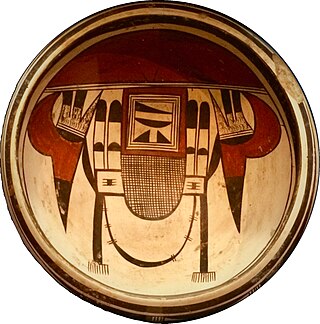
Fannie Nampeyo (1900–1987) was a modern and contemporary fine arts potter, who carried on the traditions of her famous mother, Nampeyo of Hano, the grand matriarch of modern Hopi pottery.
The Pueblo linguistic area is a Sprachbund consisting of the languages spoken in and near North American Pueblo locations. There are also many shared cultural practices in this area. For example, these cultures share many ceremonial vocabulary terms meant for prayer or song.
Polacca is an unincorporated community in Navajo County, of northeastern Arizona, United States. It is Hopi-Tewa community on the Hopi Reservation.

Art of the American Southwest is the visual arts of the Southwestern United States. This region encompasses Arizona, New Mexico, and parts of California, Colorado, Nevada, Texas, and Utah. These arts include architecture, ceramics, drawing, filmmaking, painting, photography, sculpture, printmaking, and other media, ranging from the ancient past to the contemporary arts of the present day.
Arizona, a state in the southwestern region of the United States of America, is known for its high population of Native Americans. Arizona has the third highest number of Native Americans of any state in the Union. Out of the entire US population of 2.9 million Native Americans, roughly 286,680 live in Arizona, representing 10% of the country's total Native American population. Only California and Oklahoma have more Native Americans than Arizona by number. Arizona also has the highest proportion of land allocated to Native American reservations, at 28%. Arizona has five of the twelve largest Indian reservations in the United States, including the largest, the Navajo Nation, and the third-largest, the Tohono O'odham Nation. Also, Arizona has the largest number of Native American language speakers in the United States.

Dextra Quotskuyva Nampeyo is a Native American potter and artist. She is in the fifth generation of a distinguished ancestral line of Hopi potters.

Paul V. Kroskrity is an American linguistic anthropologist known primarily for his contributions to establishing and developing language ideology as a field of research. He is professor of anthropology, applied linguistics, and American Indian Studies at the University of California, Los Angeles. He is the past President of the Society for Linguistic Anthropology and past Chair of the American Indian Studies program at the University of California, Los Angeles.

Priscilla Namingha Nampeyo was a Hopi-Tewa potter who was known for her traditional pottery. Namingha mined her own clay and created her own pigments for her large pots. Her work is in the collection of several museums and cultural centers.
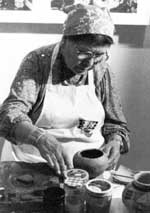
Daisy Hooee Nampeyo was a Hopi-Tewa potter. She studied at École des Beaux-Arts. Hooee taught pottery making on the Zuni reservation and helped preserve the traditional techniques she learned from her grandmother, Nampeyo.
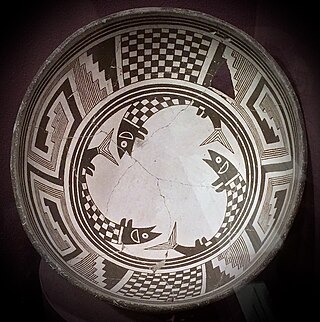
Pueblo pottery are ceramic objects made by the indigenous Pueblo people and their antecedents, the Ancestral Puebloans and Mogollon cultures in the Southwestern United States and Northern Mexico. For centuries, pottery has been central to pueblo life as a feature of ceremonial and utilitarian usage. The clay is locally sourced, most frequently handmade, and fired traditionally in an earthen pit. These items take the form of storage jars, canteens, serving bowls, seed jars, and ladles. Some utility wares were undecorated except from simple corrugations or marks made with a stick or fingernail, however many examples for centuries were painted with abstract or representational motifs. Some pueblos made effigy vessels, fetishes or figurines. During modern times, pueblo pottery was produced specifically as an art form to serve an economic function. This role is not dissimilar to prehistoric times when pottery was traded throughout the Southwest, and in historic times after contact with the Spanish colonialists.
Paqua Naha, also known as "Frog Woman", was a Hopi-Tewa potter. She worked in the "black-and-red on yellow" style of pottery, which Nampeyo popularized as Sikyátki revival ware. She became well known as a potter by the 1920s and started using a frog hallmark to sign her works. Late in her career, she experimented with white slips and innovated a whiteware technique. Naha was the matriarch of the Naha/Navasie family, and several of her descendants went on to become notable potters in their own right, including Joy Navasie and Helen Naha. Her works are included in the collections of the National Museum of the American Indian, the Museum of Northern Arizona, and the Heard Museum.












